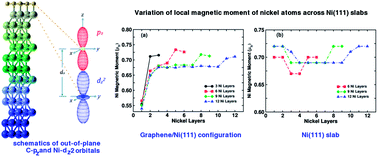Graphene–ferromagnet interfaces: hybridization, magnetization and charge transfer
Abstract
Electronic and magnetic properties of

* Corresponding authors
a
Department of Physics, University at Buffalo, State University of New York, Buffalo, New York 14260, USA
E-mail:
tesfayea@buffalo.edu, pzhang3@buffalo.edu
b Department of Chemistry, University at Buffalo, State University of New York, Buffalo, New York 14260, USA
c Beijing Computational Science Research Center, Beijing 100084, China
Electronic and magnetic properties of

 Please wait while we load your content...
Something went wrong. Try again?
Please wait while we load your content...
Something went wrong. Try again?
T. Abtew, B. Shih, S. Banerjee and P. Zhang, Nanoscale, 2013, 5, 1902 DOI: 10.1039/C2NR32972G
To request permission to reproduce material from this article, please go to the Copyright Clearance Center request page.
If you are an author contributing to an RSC publication, you do not need to request permission provided correct acknowledgement is given.
If you are the author of this article, you do not need to request permission to reproduce figures and diagrams provided correct acknowledgement is given. If you want to reproduce the whole article in a third-party publication (excluding your thesis/dissertation for which permission is not required) please go to the Copyright Clearance Center request page.
Read more about how to correctly acknowledge RSC content.
 Fetching data from CrossRef.
Fetching data from CrossRef.
This may take some time to load.
Loading related content
